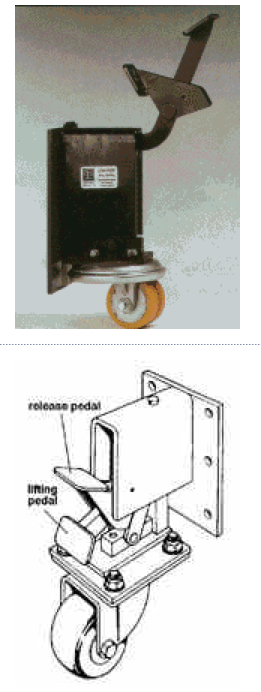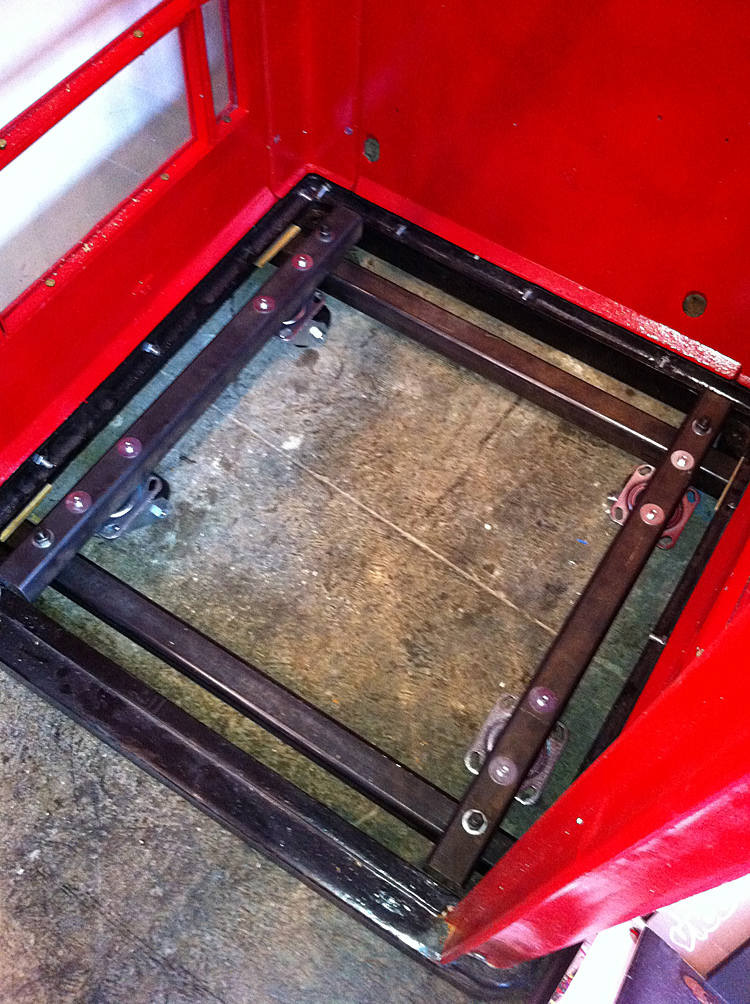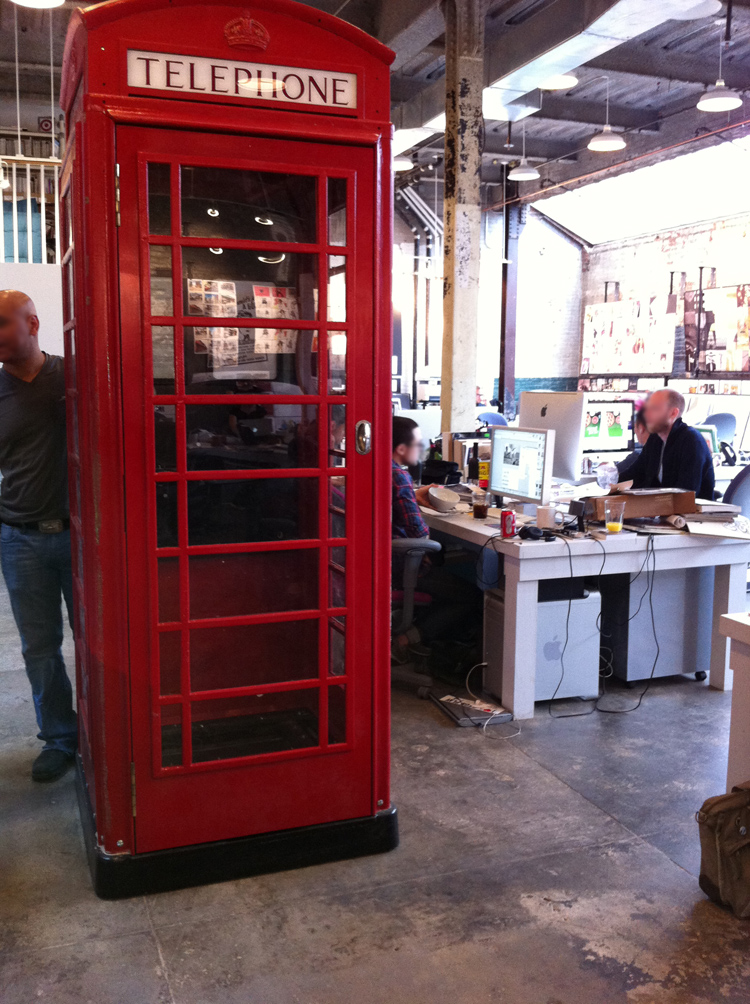Lifting capacity of a bolt ?
-
@unknownuser said:
Can you weld a threaded bushing in that box iron? It'd beef up the strength and reduce the load on the nut.
yeah, that's sort of what the .skp meant when i said adding a spacer.. (though i'm thinking about using epoxy to glue it in there instead of welding).. it wouldn't be threaded though -- i was thinking of using a 1/2" spacer if i opt for a 3/8" bolt just to give a little wiggle room.
i'm not really figuring out the chart you linked to.. apparently, a 3/8" bolt will be plenty strong but i just don't know if i'll be able to apply enough torque for the lift.. i'm hoping to use my impact driver to do it which delivers ~1400 in.lbs.
what do you think the torque listings mean on that chart?
[edit] maybe double up the nut in order to spread out the load per nut?
[edit2].. hmm.. ok. i'm seeing the tensile strength section now.. maybe i'll go with some 1/2" grade5 bolts.
-
hi Jeff,
We do this type of thing all the time for Special Effects rigs.
my advice is use turn as large a course threaded bolt as you can fit, with a nut welded to the frame.
You can only lift one pitch per revolution, so 25TPI will take 25 turns per inch,
I have welded bicycle sprockets on a four bolt set and ran a single chain around, but it's a bit of a pain to set up.
john
-
Oh well never mind,
Not that then but these..... in an ideal world where money is no object.

(If you do go for wiggle room with the bolt you might want to guide the castor beam while it lifts to keep the castors vertical before they get locked off)
The first time i made something like this with swivel castors i welded them too close to the outer frame so they wouldn't flip around....resulted in limited navigation and a rebuild.... the sort of thing you only do once.
Sam
-
@unknownuser said:
what do you think the torque listings mean on that chart?
Its the value at which the bolt is considered tight. Where as your 'invention' isn't relying on bolt tightness but drive. That's a different kettle of fish.
I can't view the file as I'm browsing on iPad. But I'm presuming you're raising and lowering this skirt that's 1600lbs? In order to roll this doodad about?
If so the skirt is suspended on the nuts. Tightness or torque isn't necessary but you'll apply torque to raise it. The force acting down on those nuts will mean sweaty Jeff. If you had a threaded spacer/bushing it would mean more mechanical action than brute force. Also a bolt with a double start would reduce the number of rotations needed as John mentioned. And a nice acme or buttress thread would ensure longevity.
I could be looking at this incorrectly

-
@unknownuser said:
@unknownuser said:
what do you think the torque listings mean on that chart?
Its the value at which the bolt is considered tight. Where as your 'invention' isn't relying on bolt tightness but drive. That's a different kettle of fish.
I can't view the file as I'm browsing on iPad. But I'm presuming you're raising and lowering this skirt that's 1600lbs? In order to roll this doodad about?
If so the skirt is suspended on the nuts. Tightness or torque isn't necessary but you'll apply torque to raise it. The force acting down on those nuts will mean sweaty Jeff. If you had a threaded spacer/bushing it would mean more mechanical action than brute force. Also a bolt with a double start would reduce the number of rotations needed as John mentioned. And a nice acme or buttress thread would ensure longevity.
I could be looking at this incorrectly

nah.. i think you're seeing it right. (except i don't need longevity.. lift/move/lower/done.
i definitely don't mind getting sweaty though so that's not a problem:D
the problem with some of the welding suggestions etc. are more of a logistical problem.. my welding machine is in storage in long island city (queens) and the lift is in hell's kitchen (west side manhattan).. and i don't own a vehicle..
these people are loaded though so if i said you need suchANDsuch contraption to move this thing then they'd do it.. it's more of a personal challenge of mine to move it for 25 bucks or less
 .. well, that and i have a chance to resell some steel and casters that i happen to have which are doing nothing but taking up space and collecting dust.
.. well, that and i have a chance to resell some steel and casters that i happen to have which are doing nothing but taking up space and collecting dust.i think i'm good to go.. i'll post a picture of the thing when it's being moved.
it's a pretty cool object (at least to an american? you euros might give it a meh..) -
@unknownuser said:
@unknownuser said:
@unknownuser said:
what do you think the torque listings mean on that chart?
Its the value at which the bolt is considered tight. Where as your 'invention' isn't relying on bolt tightness but drive. That's a different kettle of fish.
I can't view the file as I'm browsing on iPad. But I'm presuming you're raising and lowering this skirt that's 1600lbs? In order to roll this doodad about?
If so the skirt is suspended on the nuts. Tightness or torque isn't necessary but you'll apply torque to raise it. The force acting down on those nuts will mean sweaty Jeff. If you had a threaded spacer/bushing it would mean more mechanical action than brute force. Also a bolt with a double start would reduce the number of rotations needed as John mentioned. And a nice acme or buttress thread would ensure longevity.
I could be looking at this incorrectly

nah.. i think you're seeing it right. (except i don't need longevity.. lift/move/lower/done.
i definitely don't mind getting sweaty though so that's not a problem:D
the problem with some of the welding suggestions etc. are more of a logistical problem.. my welding machine is in storage in long island city (queens) and the lift is in hell's kitchen (west side manhattan).. and i don't own a vehicle..
these people are loaded though so if i said you need suchANDsuch contraption to move this thing then they'd do it.. it's more of a personal challenge of mine to move it for 25 bucks or less
 .. well, that and i have a chance to resell some steel and casters that i happen to have which are doing nothing but taking up space and collecting dust.
.. well, that and i have a chance to resell some steel and casters that i happen to have which are doing nothing but taking up space and collecting dust.i think i'm good to go.. i'll post a picture of the thing when it's being moved.
it's a pretty cool object (at least to an american? you euros might give it a meh..)Jeff
Make sure you look at what, if any, move obstacles you have to cross. I am sure you have seen the pics of Obama limo getting high centered. When moving equipment we usually worried any ramps, thresholds etc we had to cross to make sure there was clearance in our design and for your case possible over turning -
hey mac, thanks
yeah, i'm ok in that dept.. the floor is level and has 22' ceilings throughout.. at the tightest part of the move (laterally), i'll have 3' clearance on either side.. there's one spot in the concrete that could be a bit of a problem (kinky expansion joint) but i have some 16 gauge sheet stock to lay over it..fwiw, i've moved much(much!) heavier objects before for longer (much longer!) distances but i've had a crew and heavy duty machinery.. my crew doesn't live in nyc and there's no way to get any sort of forklift or crane inside this building..
i'm feeling ok about this safety wise especially because i'm only going up less than an inch.. i guess my main worry is being halfway into the raising or lowering process and have one of the bolts strip out.
-
@driven said:
hi Jeff,
We do this type of thing all the time for Special Effects rigs.
my advice is use turn as large a course threaded bolt as you can fit, with a nut welded to the frame.
You can only lift one pitch per revolution, so 25TPI will take 25 turns per inch,
I have welded bicycle sprockets on a four bolt set and ran a single chain around, but it's a bit of a pain to set up.
john
nice.. glad to hear that this isn't such an uncommon thing to do

i'm hoping my impact wrench will take care of most of the turning. if not, i'll have a ratchet with extension arm but i hope it doesn't come down to that.. the rest of the thing extends vertically so it's not like i can just put a socket on there and do 360s with it.. if i have to tighten it manually, i'll be turning the nuts 90º at a time
-
@unknownuser said:
it's a pretty cool object (at least to an american? you euros might give it a meh..)
I look forward to it. But I'm more interested in how you get on?
-
@unknownuser said:
hey mac, thanks
yeah, i'm ok in that dept.. the floor is level and has 22' ceilings throughout.. at the tightest part of the move (laterally), i'll have 3' clearance on either side.. there's one spot in the concrete that could be a bit of a problem (kinky expansion joint) but i have some 16 gauge sheet stock to lay over it..fwiw, i've moved much(much!) heavier objects before for longer (much longer!) distances but i've had a crew and heavy duty machinery.. my crew doesn't live in nyc and there's no way to get any sort of forklift or crane inside this building..
i'm feeling ok about this safety wise especially because i'm only going up less than an inch.. i guess my main worry is being halfway into the raising or lowering process and have one of the bolts strip out.
Roger sounds like you have the bases covered.
FYI: Don't know the dollar value of the item you are moving nor your liability. For ground handing equipment we usually apply a large safety factor.
Have moved ( technical management resp.)items via Fed X , air ride vans, bought the total first class section seats of United 727 one time so all the electronics could be strapped in the first class seats, over the road coast to coast and even almost filled a C5A with 1 item. All total maybe around 3/4 billion dollars. Move never goes as smooth as I would like( Had a really bad experience with D ring )
Good Luck -
so i ordered some of these today:
hopefully they aren't too coarse.
-
Sorry if I missed this in the discussion and/or it is missing from the drawing detail, but how do you plan on preventing the bolt from turning as you tighten the nut?
It's possible this may not be a problem using the impact driver, but if it is you may need to have another wrench to keep the bolt from turning. There appears to be 2" clearance, which should be just enough room to get a wrench on it.
(edit - probably stating the obvious.)
-
@jim said:
Sorry if I missed this in the discussion and/or it is missing from the drawing detail, but how do you plan on preventing the bolt from turning as you tighten the nut?
It's possible this may not be a problem using the impact driver, but if it is you may need to have another wrench to keep the bolt from turning. There appears to be 2" clearance, which should be just enough room to get a wrench on it.
(edit - probably stating the obvious.)
yeah, a combination wrench on the other side.. i got the flange bolts with serrated edges which will help a little bit by biting into the tube..
the tube is actually 2x2 (1/4" wall) so that's why i got the 5" bolt... at the end of it all, the bolt will stick up an inch so a socket will still have clearance. -
Go Jeff!

-
i found this online calculator that will give you the necessary torque for an applied weight
my results are saying that i should be able to do this with my impact wrench (capable of 1400 in.lbs torque).

that said, it did give me a warning when i entered the receptacle length of 1/4" which is how the lift would start off with the 5" bolts (the nut wouldn't fully encapsulate the bolt until i lifted 1/2") and they recommend 3x the bolt diameter as the receptacle length... so, i changed my bolt order to get some longer bolts which will allow all the threads of the nut to contact the bolt prior to taking on any weight.
it's gonna delay the move a few days but hey.. better safe than sorry right?

-
That's an interesting 'torque calculator' you found.
Are they Grade 2 4140 bolts you're installing? Either way grease them up to lower the torque required though you're probably well aware of that.
I used to install 1.5" stainless steel cone bolts in MD-80's with a 4' torque wrench. Then go up on test flight. All that was in my head was 'i hope those f$%king bolts were ok'.
-
@unknownuser said:
That's an interesting 'torque calculator' you found.
Are they Grade 2 4140 bolts you're installing? Either way grease them up to lower the torque required though you're probably well aware of that.
they're actually grade 8 bolts which i thought would be super expensive but they were only 6 bucks each (ok, relatively super expensive but i only need four of them soo..
 )
)the bolts are way too strong for what i need them for but i don't mind..
thing is, i'll be doing this in an open air ad agency with maybe 100 or so people inside.. many of those people are rather beautiful women and i think i'm a bit more worried about them seeing something go wrong as opposed to simply being worried about something going wrong
 ..so i'm just making sure i have all bases covered.
..so i'm just making sure i have all bases covered.@unknownuser said:
I used to install 1.5" stainless steel cone bolts in MD-80's with a 4' torque wrench. Then go up on test flight. All that was in my head was 'i hope those f$%king bolts were ok'.
what?! are you serious? that's crazy sounding.. (though i wonder how many md80s i've been on with less than optimal bolts/rivets etc.. or do those types of things get checked fairly thoroughly/regularly ?)
-
.
ok.. so 1655 lbs worth of K6 - British Red Telephone Box has been successfully relocated by a single person

and it was actually a lot easier than i was thinking it would be.. everything went very smooth.. maybe a bit over engineered as far as the quality of bolts and steel thickness i used but -oh well... ended up just using a ratchet to tighten the bolts -- i don't think 1000 lbs of torque is as much force as it sounds like.. or maybe i'm just superman



-
Torque= Force x Lenght
So divide the torque by length of wrench to figure out how much force you applied to reach that torque. In/lbs are different from ft/lbs but I'm sure you're aware of that.
If I'd known you were lifting that I'd have suggested the Irish method known as 'horsin' into place'
-
Ha. Yeah, I would of approached it differently if my crew was nearby but flying them into NYC for this would of been a bit overboard. My method is called "move that s@!&, A$$h@?3" which Is probably similar to horsin.
And I didn't feel too comfortable asking people with fancy fingernails playing on fancy computers to help out with the grunt technique

Advertisement







